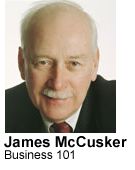 |
|
|
YOUR
COUNTY.
|
YOUR
BUSINESS JOURNAL.
|
Published December 2000
Wise
borrowing can lead
to expansion, profits
 Borrowed
money plays a key role in business growth. After a business has exhausted
the potential of its initial capital investment from the “Three F’s” (friends,
family and fools), it may find itself in an unwanted state of low or zero
growth.
Borrowed
money plays a key role in business growth. After a business has exhausted
the potential of its initial capital investment from the “Three F’s” (friends,
family and fools), it may find itself in an unwanted state of low or zero
growth.
A zero-growth business presents its own sort of problems. The biggest problem is survival, for businesses tend to be like trees — when they stop growing, they die. As a practical matter, most firms simply do not have access to equity capital markets, so if money is needed to support growth, it will have to be borrowed, most often from a bank.
If used properly, borrowed money can make a valuable contribution to a firm’s health and outlook. It is important, though, to understand what exactly borrowed money can, and cannot, do for you. To see the impact of borrowing, imagine you run a company that owes its start to your uncle Eugene.
It is a very simple company. Once a month, it buys a trailer full of, say, electric balungas, repackages them as single items and retails them for twice what they originally cost. After deducting the costs of the repackaging and retailing, and after Eugene extracts his cut, there is just enough money left to buy another trailer load. The company is in zero-growth equilibrium, and its key financials look like this:
| Beginning inventory: | $10,000 |
| Sales: | $20,000 |
| Packaging/retail costs: | $5,000 |
| Eugene’s take: | $5,000 |
| Profit: | $0 |
If you could borrow $10,000 from the bank, though, you would be able to buy two trailer loads of balungas, and your key financials would look like this:
| Beginning inventory: | $20,000 |
| Notes payable: | $10,000 |
| Sales: | $40,000 |
| Packaging/retail costs: | $10,000 |
| Eugene’s take: | $5,000 |
| Profit: | $5,000 |
At the end of the month, then, there would be enough cash to pay Uncle Eugene his usual amount, replace the inventory by buying two more trailer loads of balungas — without borrowing more — and by accumulating the $5,000 in profit, you would be halfway to paying off the bank note.
While this example shows the value of borrowed funds, it is obviously a highly simplified version of what really goes on in a business. It does allow us to change assumptions one by one, to identify the key variables in the business and how borrowed funds can affect them. The one exception to this is the assumption related to Uncle Eugene, who wants his money but does not wish to draw attention to himself.
In the original model, for example, you can sell every balunga you can get your hands on, at your price. In the real world, very few firms enjoy that kind of market. To make the model more realistic, then, you need to estimate real sales growth. This will tell you how long it will take to sell off the additional trailer load of balungas, and you can balance this against the cost of carrying the inventory (in this case, the cost of borrowing the money to buy it).
The other major assumption we made was that sales translated immediately into cash — that is, there are no “accounts receivable” where you have to wait to get your money. This is not a totally unreal assumption for retail sales operations, but it would be for other types of businesses.
Banks are only modestly enthusiastic about lending money for inventory purchases, because they don’t want to get stuck with, say, half a trailer of balungas. They do like solid financial models, though, and if you can show how borrowed funds will work for your bottom line, they are likely to say, “that sounds like a plan,” and you can pocket the additional profits.
James McCusker, a Bothell economist, educator and small-business consultant, writes “Your Business” in The Herald each Sunday. He can be reached by e-mail on the Internet at otisrep@aol.com.
© The Daily Herald Co., Everett, WA








